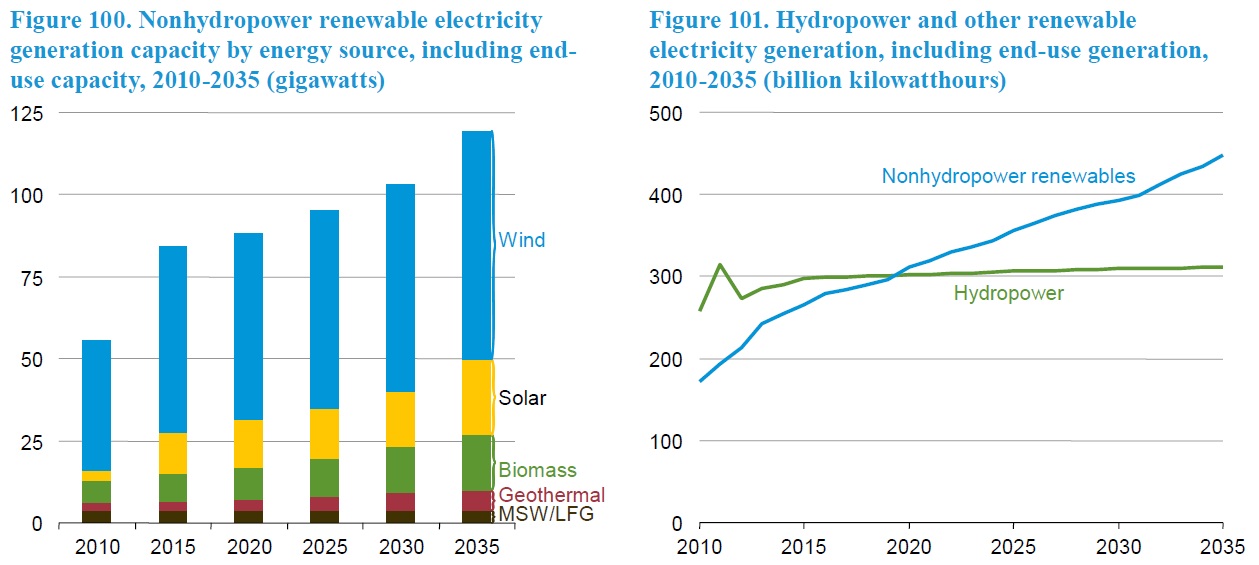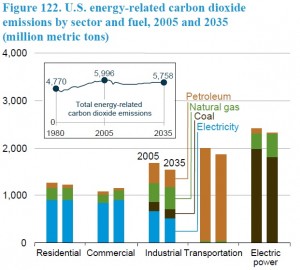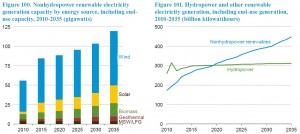
A Breakdown of EIA’s new Annual Energy Outlook Report
In November, the International Energy Agency’s World Energy Outlook report announced positive prospects for U.S. energy, specifically the U.S. overtaking Saudi Arabia as the world’s largest oil producer before 2017. The U.S. Department of Energy’s Energy Information Agency (EIA) added to the good news this week with their Annual Energy Outlook 2013 Early Release Overview report that predicts greater oil production; improved fuel efficiency; the U.S. becoming a net exporter of natural gas; and rise in natural gas and renewables’ shares of electricity generation. This is all good news for energy producers in the country.
The report found that oil production will experience an annual production growth of 234,000 barrels of oil per day through 2019. This increase in production will derive largely from onshore oil production. EIA expects domestic crude oil production to increase by more than 1 million barrels a day by 2020, to 7.5 million barrels per day. Corresponding with this rise in production is a decrease in foreign imports by a quarter between 2010 and 2020.
Natural gas usage in the industrial sector will increase from 6.8 trillion cubic feet per year in 2011 to 7.8 cubic feet per year in 2025. The EIA also finds that in the electric power sector, natural gas will continue to capture market share from coal, rising from 24% of electricity generation today to 27% in 2020 and 30% by 2040.
Motor gasoline consumption is projected to fall due to tougher corporate fuel economy standards. Separate from the report, the Department of Transportation found in September that travel on all roads and streets decreased by 1.5% or 3.6 billion vehicle miles compared to a year ago, demonstrating soft demand in the transportation sector for the foreseeable future.
The EIA predicts that by 2016 the U.S. will become a net exporter of liquefied natural gas and by 2020 net exporter of total natural gas, two years earlier than last year’s projections. This year’s report added that the U.S. is projected to export 1.8 trillion cubic feet of liquid natural gas by 2020, double that of the last year’s projection.
Solar, wind and other renewables only make modest gains over the time frame representing 15% of electricity generation by 2035, up from 13% today. Biofuel consumption is expected to increase by 1.2 million barrels per day between 2010 and 2035. Most of this biofuel will be produced domestically.
While the energy outlook seems promising, the downside is the climate picture. The EIA doesn’t expect U.S. energy related carbon dioxide emissions to decrease significantly – carbon dioxide emissions will only decline by 5% between 2005 and 2035.
 Meanwhile, scientists released an article in the Nature Climate Change journal on December 2nd, stating that they expect a 2.6% rise in worldwide emissions this year. Also, the World Bank recently released a report suggesting that the world may be on a trajectory in which the climate is changing more rapidly than previously thought.
Meanwhile, scientists released an article in the Nature Climate Change journal on December 2nd, stating that they expect a 2.6% rise in worldwide emissions this year. Also, the World Bank recently released a report suggesting that the world may be on a trajectory in which the climate is changing more rapidly than previously thought.
The EIA report reflects the ongoing enthusiasm over surging oil and gas production in the United States. While this can be seen as good news, the fact remains that fossil fuel production will begin to decline at some point. The United States still needs clean, safe, and abundant sources of energy over the long-term.







[…] A Breakdown of EIA’s new Annual Energy Outlook Report […]